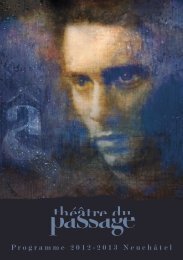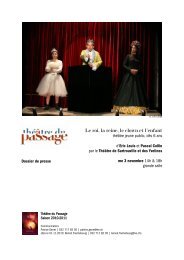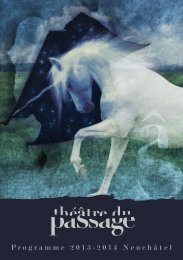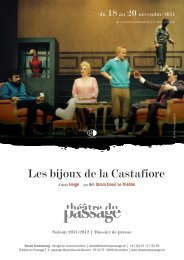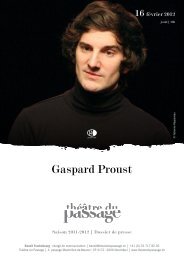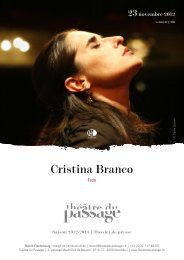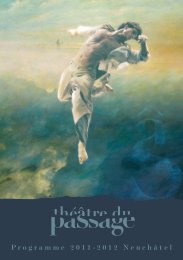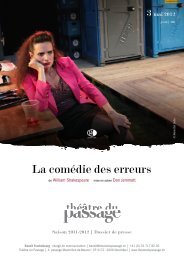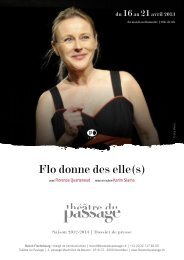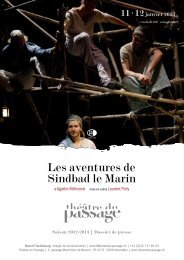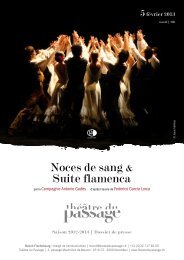BIOGRAPHIE COLLABORATEURS - Théâtre du Passage
BIOGRAPHIE COLLABORATEURS - Théâtre du Passage
BIOGRAPHIE COLLABORATEURS - Théâtre du Passage
You also want an ePaper? Increase the reach of your titles
YUMPU automatically turns print PDFs into web optimized ePapers that Google loves.
MUSIC FOR NEW WORK WITH ÉDOUARD LOCKThe music is based on two baroque works: Purcell ‗s Dido and Aeneas and Gluck's Orpheus and Eurydice.It is played live by four on-stage musicians: saxophone(s), viola, cello, and piano, where the apparentlyinauthentic saxophone is a surrogate for the human voice in the lighter, more airy, Purcell-related material,and forms part of the "continuo" for the darker Orpheus material (accepting that the continuo had becomeobsolete by the early classical period). For the first part, the saxophone will be soprano or alto, and for thesecond part, baritone. This on-stage ensemble is amplified as part of an overall sound design, as with allÉdouard's work, and will be directed from the piano.While the choice of saxophone as the main solo instrument may appear odd, given that it is a 19thcentury invention, there are many aspects of its character which make it eminently suitable. The naturalchoice for soloist might seem to have been the human voice, but the saxophone, on the other hand,happens to be an essentially "vocal" instrument – it is of course grouped vocally (soprano, alto, tenor,baritone, bass, etc.), and one player can play more than one of these within the same performance,impossible with the human voice. When I wrote my first opera 28 years, I noted carefully the instrumentalideas of Percy Grainger, who often used saxophones with choral groups mixing voices and instrumentswith the same name (soprano saxes with soprano voices and so on), and a sax ensemble is often referredto as a saxophone "choir." At the same time, while the sax does cover the same range as the equivalenthuman voice, its range is enormously wider (the alto, for example, can also play at least two octavesmore). With the saxophone, too, there is the possibility of much longer phrase lengths than with thehuman voice, even without the use of circular breathing – which enables the player to play infinitely longphrases with no perceivable break at all. The sax's sound is a hybrid one and is not fixed by period –Grainger arranged a good deal of early music for saxophones and this choiceworks very well.The other instruments in the chamber ensemble are more clearly compatible with the baroque. While therewould be no need to work in an entirely "authentic" way (baroque tuning, for example, would beproblematic for the saxophone unless further transposition is used), the use of baroque bows andparticular types of strings (not necessarily gut) would move some way in this direction. There is a strongcontemporary lobby for simply using the baroque bow, and little else, to move towards a baroquesensibility.By Gavin Bryars




